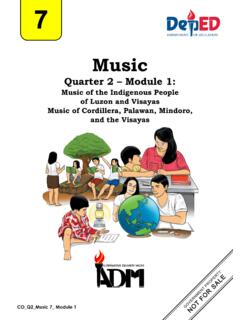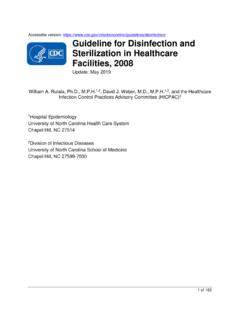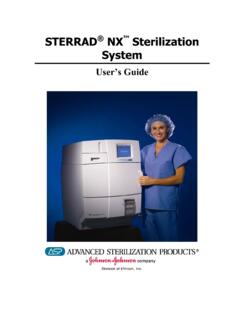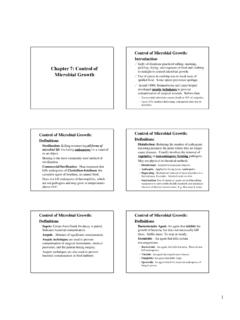Transcription of Quarter 2 Module 2 - ASNHS
1 Science Quarter 2 Module 2: Practical Applications and Effects of Electromagnetic Waves 10 Science Grade 10 Alternative Delivery Mode Quarter 2 Module 2: Practical Applications and Effects of Electromagnetic Waves First Edition, 2020 Republic Act 8293, section 176 states that: No copyright shall subsist in any work of the Government of the Philippines. However, prior approval of the government agency or office wherein the work is created shall be necessary for exploitation of such work for profit. Such agency or office may, among other things, impose as a condition the payment of royalties. Borrowed materials ( , songs, stories, poems, pictures, photos, brand names, trademarks, etc.) included in this Module are owned by their respective copyright holders.
2 Every effort has been exerted to locate and seek permission to use these materials from their respective copyright owners. The publisher and authors do not represent nor claim ownership over them. Published by the Department of Education Secretary: Leonor Magtolis Briones Undersecretary: Diosdado M. San Antonio Printed in the Philippines by _____ Department of Education Region I Office Address: Flores St., Catbangen, City of San Fernando, La Union Telefax: (072) 682-2324; (072) 607-8137 E-mail Address: Development Team of the Module Writer: Cecilia D. Macaranas Editors: Ma. Maila C. Justo Emily P. Tandog Reviewers: Jaime Campos, Jr. Jerry R. Junio Elnora Raroque Rodrigo Q.
3 Reyes, Jr. Ellen F. Fernandez German J. Ferrer Jr. Ma. Criselda G. Ocang Gina A. Amoyen Illustrator: Richard C. Paragas Layout Artist: Reyna H. Talinio Management Team: Tolentino G. Aquino Arlene A. Niro Carmina C. Gutierrez Gina A. Amoyen Rustico P. Abalos, Jr. Editha T. Giron Marilou D. Roldan Jerry R. Junio 10 Science Quarter 2 Module 2: Practical Applications and Effects of Electromagnetic Waves ii Introductory Message This Self-Learning Module (SLM) is prepared so that you, our dear learners, can continue your studies and learn while at home. Activities, questions, directions, exercises, and discussions are carefully stated for you to understand each lesson.
4 Each SLM is composed of different parts. Each part shall guide you step-by-step as you discover and understand the lesson prepared for you. Pre-tests are provided to measure your prior knowledge on lessons in each SLM. This will tell you if you need to proceed on completing this Module or if you need to ask your facilitator or your teacher s assistance for better understanding of the lesson. At the end of each Module , you need to answer the post-test to self-check your learning. Answer keys are provided for each activity and test. We trust that you will be honest in using these. In addition to the material in the main text, Notes to the Teacher are also provided to our facilitators and parents for strategies and reminders on how they can best help you on your home-based learning.
5 Please use this Module with care. Do not put unnecessary marks on any part of this SLM. Use a separate sheet of paper in answering the exercises and tests. And read the instructions carefully before performing each task. If you have any questions in using this SLM or any difficulty in answering the tasks in this Module , do not hesitate to consult your teacher or facilitator. Thank you. 1 What I Need to Know Are you not wondering how you are able to communicate with your loved ones from far places? How were you able to listen to music from your radio? Or how your television remote control works? Most of the things we use nowadays are applications of our knowledge about Electromagnetic (EM) waves. We may not see these EM waves, but we encounter their different forms in our daily life.
6 You know more of these waves than you may think. This Module contains various activities and tasks to be accomplished which will give you more understanding on the significance and effects of electromagnetic waves. At the end of this Module you will be able to: 1. cite examples of practical applications of the different regions of EM waves, such as the use of radio waves in telecommunication (S10FE-IIc-d-48); 2. explain the effects of electromagnetic radiation on living things and the environment (S10FE-IIe-f-49). What I Know Directions: Read each question carefully. Choose the letter of the correct answer. 1. What EM wave make cellular telephones transmit and receive signals? A. radio waves C. visible light B. microwaves D. gamma rays 2.
7 All of the following are uses of visible light. Which one is not? A. it enables us to see things C. for thermal imaging B. gives light to the screen of our devices D. used in optical fibers 3. Which kind of wave is use in night vision goggles? A. microwave C. gamma ray B. infrared D. visible light 4. Which of the following EM wave makes use of artificial lighting? A. visible spectrum C. gamma rays B. x-ray D. infrared 2 5. Which of the following is a use of ultraviolet radiation? A. diagnosing bone fracture C. night vision goggle B. identifying original from fake banknotes D. optical fiber 6. Which type of X-ray can penetrate even through metals? A. regular X-ray C. short wavelength X-ray B.
8 Long wavelength X-ray D. dental X-ray 7. What type of electromagnetic waves is used in RADAR? A. infrared rays C. radio waves B. microwaves D. ultraviolet rays 8. What imaging technique uses powerful magnets, computer and radio waves to make detailed pictures inside your body? A. thermal imaging C. Magnetic Resonance Imaging (MRI) B. infrared imaging D. X-ray image 9. In an infrared camera, what color indicates warmer temperature? A. blue C. violet B. green D. yellow 10. Which of the EM waves below are emitted by stars and some radioactive substances? A. gamma rays C. microwave B. radio waves D. X-ray 11. Which kind of wave causes the fluorescent chemicals to glow in sunlight? A. microwave C.
9 Gamma ray B. ultraviolet D. visible light 12. How many of the EM waves are visible? A. none out of seven EM waves C. all of the EM waves B. most of it D. only one out of seven EM waves 13. Among the following forms of the EM spectrum, which waves do not have enough energies to damage the body cells? A. gamma ray and infrared C. gamma ray and ultraviolet B. radio wave and visible light D. X-ray and ultraviolet 14. What kind of wave is very dangerous, but have been used to kill cancer cells? A. gamma rays C. radio waves B. infrared D. visible light 15. Which of the following sets of EM radiation can harm your body cells? A. gamma ray, ultraviolet ray, X-ray C. infrared, microwaves, ultraviolet B. light, ultraviolet , X-ray D.
10 Gamma ray, microwaves, infrared 3 Lesson 1 Practical Applications and Effects of Electromagnetic Waves What s In Can you still remember the different forms of Electromagnetic waves you have learned from the previous Module ? While all these EM waves move through space at the same speed of about three hundred (300) million meters per second, their wavelengths, frequencies, and energies differ. This is the reason why they are arranged accordingly in a scheme called Electromagnetic Spectrum. Let me remind you that wavelength has an inverse relation with frequency and energy. So, if wavelength increases, what will happen to the frequency of the wave? If the wavelength of an EM wave decreases, what will be the effect in its energy? Let s compare the relative wavelengths, frequencies, and energies of the different regions of the Electromagnetic spectrum.








